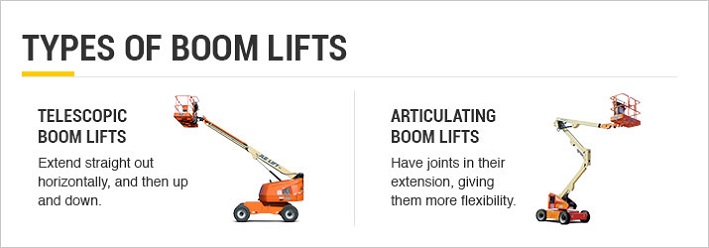Need to reach high places safely and efficiently? Boom lifts are the go-to solution for various industries, from construction to maintenance work. But with so many options available, choosing the right one can be confusing. Understanding the different types of boom lifts can help you pick the best equipment for your specific needs.
In this guide, we’ll break down the boom lift types, their features, and how they are used in different industries.
What Are Boom Lifts?
A boom lift is a type of aerial work platform used to lift workers and materials to high or hard-to-reach areas. These machines are commonly seen in construction, maintenance, painting, and warehouse operations. They provide better reach and mobility compared to traditional ladders or scaffolding, making them essential for tasks that require working at height.
The two main types of boom lifts are:
- Articulating Boom Lifts – These have multiple joints that allow them to bend and reach over obstacles.
- Telescopic Boom Lifts – These have a straight arm that extends out, offering a greater horizontal reach.
Both types serve unique purposes, making them essential in various industries.
1. Articulating Boom Lift: Best for Hard-to-Reach Areas
An Articulating Lift, also known as a knuckle boom, has multiple joints that allow it to bend and reach around obstacles. This makes it perfect for tasks that require flexibility and access to tight spaces.
Best Uses of an Articulating Lift:
Here are some best uses of articulating lifts for your projects:
- Building Maintenance – Great for reaching ceilings, walls, and pipes in warehouses and factories.
- Tree Trimming – Helps landscapers reach over fences or between branches.
- Electrical Work – Ideal for installing or repairing power lines, as it can extend around poles and obstacles.
Since these lifts can navigate tricky spots, they are often used in industrial facilities, airports, and shopping malls. Articulating lifts are ideal for indoor and outdoor projects where maneuverability is crucial.
2. Telescopic Boom Lift: Ideal for Maximum Reach
A Telescopic Lift, also known as a straight boom lift, features a single, extendable arm that provides a longer reach than an articulating boom. It is best suited for jobs that require workers to reach high areas in a straight line without the need to navigate obstacles.
Best Uses of a Telescopic Lift:
Here are some popular uses of a telescopic lift for your project:
- High-Rise Construction – Perfect for working on tall buildings and skyscrapers.
- Bridge and Tower Maintenance – Used for repairing or inspecting infrastructure.
- Stadium and Billboard Installations – Helps with setting up large signs or lighting systems.
This type of boom lift is commonly seen at large construction sites, shipyards, and outdoor events where height and stability are essential. If your job requires working at extreme heights with a stable base, a telescopic lift is the best option.
3. Diesel Boom Lift: Power and Performance
A Diesel Lift is powered by a diesel engine, making it ideal for rough terrain and outdoor environments. These lifts often come in both articulating and telescopic models, offering powerful lifting capacity and extended reach.
Best Uses of a Diesel Lift:
Here are some popular uses of a diesel lift:
- Outdoor Construction – Handles rough ground and uneven surfaces with ease.
- Oil and Gas Industry – Used for maintenance work on drilling rigs and industrial sites.
- Shipyards and Docks – Helps in loading, unloading, and maintenance of large ships.
Because of its powerful engine, it is best suited for environments where extra power and performance are needed. A diesel boom lift is a great choice when working outdoors where electric power sources may not be available.
How Do Boom Lifts Compare to Scissor Lifts?
While boom lifts offer vertical and horizontal reach, a scissor lift moves straight up and down. It is used for tasks that require a stable platform rather than extended outreach.
When to Use a Scissor Lift:
- Indoor maintenance work like fixing lights or ceilings
- Warehouse tasks requiring steady elevation
- Painting or window installation projects
If you need to move sideways or reach around obstacles, a boom lift is the better choice. But if you only need to go up and down with stability, a scissor lift is more suitable.
Choosing the Right Boom Lift for Your Project
Now that you understand the different types of boom lifts, how do you choose the right one? Consider the following factors:
- Height Requirements – How high do you need to reach? Telescopic lifts are best for extreme heights.
- Work Environment – Are you working indoors or outdoors? Diesel lifts are ideal for rough terrain, while electric models work better indoors.
- Obstacles on Site – If you need to navigate around barriers, an articulating lift is the better option.
- Weight Capacity – Scissor lifts provide the most stable platform for carrying heavier loads.
By evaluating your specific project needs, you can choose the most efficient and cost-effective boom lift.
Need the perfect boom lift for your project? Get the right equipment today for a safe, efficient, and hassle-free job—contact us now!
Conclusion
Selecting the right types of boom lifts is essential for getting the job done safely and efficiently. Whether you need the flexibility of an Articulating Lift, the height of a Telescopic Lift, the power of a Diesel Lift, or the stability of a Scissor Lift, there is a perfect lift for every task.
At DMAG Equipment Rental, we provide a wide range of boom lifts to suit your specific needs. Our experts can help you choose the best lift for your project, ensuring safety, efficiency, and affordability.
Visit our website today to learn more about our rental options and get the right equipment for your next job!

